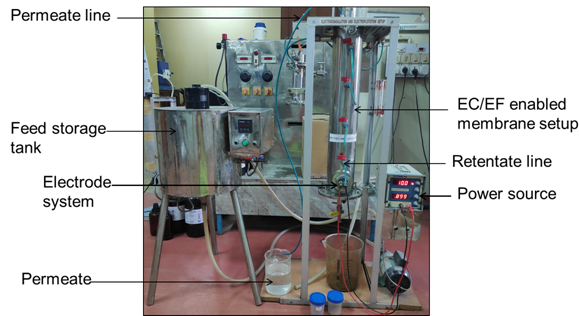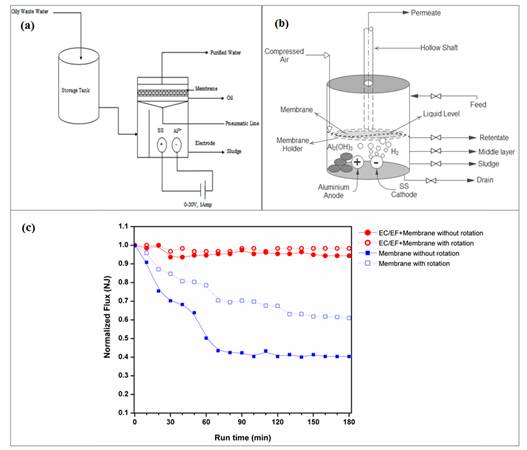The automobile servicing industry, the food industry and other small and medium scale enterprises may soon have an efficient and cost-effective electric field-assisted membrane separation device for the treatment of oily wastewater.
Most of the low-income users cannot afford the high cost of the various treatment technologies available to handle the oily wastewater generated at their source points. As a result, large quantities of untreated oily wastewater are discharged into the water bodies without following the guidelines of the Pollution Control Board.
The technology, developed by Dr. Chiranjeeb Bhattacharjee, Professor in the Department of Chemical Engineering at Jadavpur University, Kolkata, uses a combination of electrocoagulation and electroflotation Enhanced Membrane Module (ECEFMM) techniques for the treatment of wastewater. Electrocoagulation is a technique to purify wastewater that allows suspended matter to form aggregates by using an electric charge to change the surface charge of the particle, and the hydrogen and oxygen bubbles generated by electroflotation water passing electricity. Separation of suspended particles from water by using
In this developed module, electrocoagulation and electroflotation are membrane-bound in a single epigenetic setup. The stirrer caused by the seepage of hydrogen through the feed medium or wastewater resists oil deposition on the membrane. The synergistic effect of hydrogen buoyancy and the rotation of the membrane module produces substantial movement within the mixture and on the membrane surface. By application of electric field during membrane separation, membrane impurity is reduced to a great extent and membrane lifespan is also extended by prolonging membrane aging. Thus there is no need to change the membrane frequently, thereby reducing the cost of maintenance to a great extent.
Being an economically viable wastewater treatment technology (both in terms of capital and recurring investment) for small and medium scale enterprises, this innovation has good potential to be successful in the market. Furthermore, unlike other traditional methods of refining, it can break up highly stable oil-water emulsions via electric discharge and at the same time separate oil from water with extreme efficiency. Not only this, by integrating the electrochemical process setup with the membrane module in a single hybrid ECEFMM setup, a process has been eliminated. This measure significantly reduces the initial capital investment expenditure with the added benefit of less area requirement for setting up.
Developed in collaboration with the Advanced Manufacturing Technologies program of the Department of Science and Technology (DST), Government of India, this technology requires minimal manpower and does not require high technical skills to operate. Thus, it reduces the operating expenses to a great extent. The spent oil after refining oily wastewater can be used as industrial burner oil, furnace oil, mold oil, hydraulic oil, etc. Thus, this technology creates a huge revenue earning scope for low-income groups by selling the spent oil collected in this way. In an area with a dense garage, The establishment of one of its setups will serve the purpose of treating waste water and thereby expand opportunities for other low-income users to control the level of water pollution within PCB regulations. It has been aligned with the 'Make in India' initiative. Its prototype has been successfully validated and tested, and is on the verge of completion of pilot scale validation and testing.
So far, various field separation techniques for the treatment of such oily wastewater have involved the installation of an electrolytic cell or DAF followed by the installation of a membrane unit. Dr. Bhattacharjee pointed out that setting up of two separate units requires a higher footprint area than the present unit, where two-unit operations are being merged into a single unit. it occurs.
This prototype innovation has progressed to Level-6 of the Technology Readiness Level and Dr. Chiranjeeb Bhattacharjee has partnered with Concepts International to drive industrial collaboration and drive this innovation. They plan to pursue field runs with pilot-scale modules, networking and field installations, and commercialization of equipment through start-ups.

Figure 1: Electrocoagulation and Electroflotation Enhanced Membrane Module (ECEFMM)

Figure 2: (a) Schematic process flow diagram for the operation of the ECEFMM; (b) Schematic diagram for working principle of ECEFMM; (c): Comparative analysis of variation of normalized permeable flux (NJ) over time at different modes of operation.




0 Comments
please do not spam link